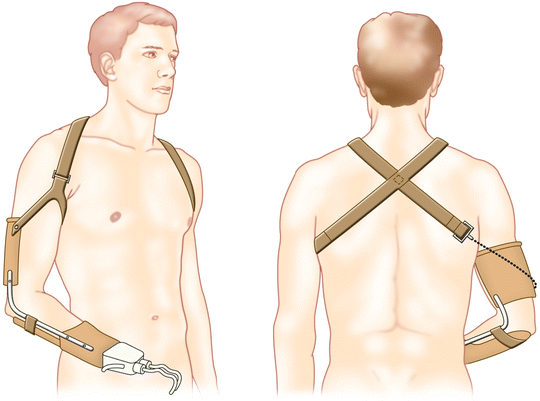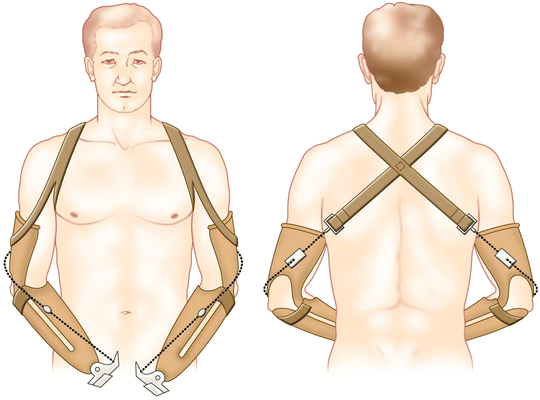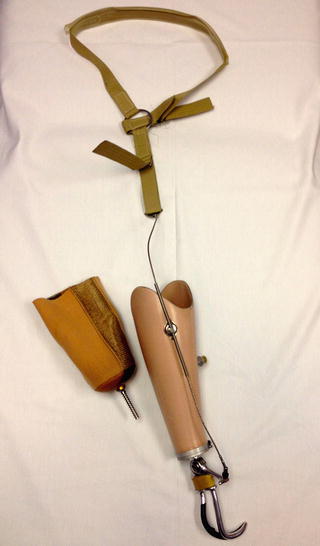Fig. 4.1
(a–d) Prosthetic terminal devices: although not cosmetic, hook-type terminal grasping devices are functional and sturdy
Transradial Deficiency
The child with a transradial deficiency will do best with a prosthesis with a socket that is self-suspending with or without a silicon sleeve. It generally will be supracondylar, going just above the elbow, using the condylar width to suspend the socket. The device can be body powered or myoelectric. A single-electrode myoelectric hand opening mechanism is relatively easy to use. The younger child may not have the strength, shoulder excursion, or cognitive development to work a body-powered device.
By the time the child starts school, they should be able to activate most types of devices. At this point, the device that is most functionally appropriate for the child should be chosen. Cosmetic considerations, while important, should not outweigh having the most useful device. Working with an experienced and open-minded prosthetist familiar with all types and brands of devices is helpful for the most thorough decision-making. A child may decide to switch the type of prosthesis depending on specific interests and activities.
Transhumeral Deficiency
A child with a transhumeral deficiency will be fitted with prosthesis even later in development. Because of elbow involvement, the transhumeral prosthesis is often too cumbersome for the infant to handle during the earlier motor developmental milestones such as rolling and crawling. A curved prosthesis with a passive hand and without an elbow hinge is a better choice for the first device. Similarly to the child with a transradial deficiency, at around the development of walking, a terminal activated device may be offered. The myoelectric hand offers good cosmesis, ease of function as the first terminal device. However, the transhumeral deficiency has the key difference of requiring a prosthetic elbow hinge, which poses a significant additional management challenge. The first elbow will be simple friction with limited range of motion to allow positioning of the terminal device, but blocking extensive flexion while weight bearing. Electric elbow components are also available and continue to evolve technologically. A harness or silicon sleeve suspends the device.
Components in More Detail
Common hook terminal devices remain the most cost-effective on practical tools in most cases. Technological advances in prosthetic design are one of the more exciting and “cutting edge” areas of rehabilitation management. However, the challenges of integrating newer technologies are cost, insurance coverage, and practical implementation. More advanced designs require higher degree of discreet control, more training, and more experience. These technologies may be most appropriate for the much older child and adult. A very exciting area of prosthetic management includes activity-specific prosthetics, such as sport-specific and work-specific attachments. Private funding for these devices is usually required, as insurance will not cover these indications.
Body-powered versus electric elbows, shoulders may be considered in the older upper limb deficient patient. The reader is referred to rehabilitation texts for discussion of technical details of these options.
Body-powered components include a figure-8 shoulder harness control over the elbow and/or terminal device is gained with glenohumeral motion and shoulder protraction and retraction. The elbow can be moved and then locked with one set of motions and then the terminal device activated with another. See Figs. 4.2 and 4.3.



Fig. 4.2
Unilateral transradial prosthesis with figure-8 harness

Fig. 4.3
Unilateral transradial prosthesis with gel pin suspension
With bilateral upper extremity deficiencies, there is no specific timetable of introduction of prosthesis. Introduction needs to be very specific and hand tailored to the individual based on developmental level and functional goals. Obviously bilateral upper limb deficiency patients are quite impaired and prosthetic fitting can be very useful if lightweight and simple to use. See Fig. 4.4.









